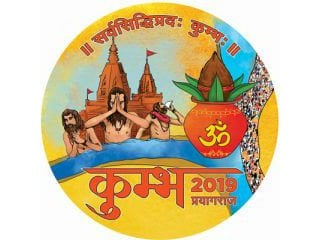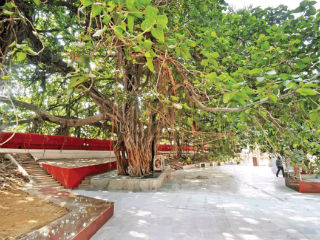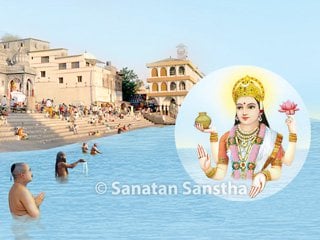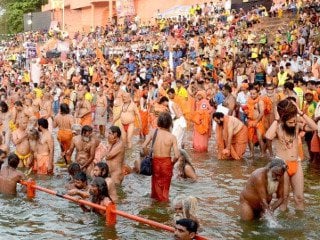1. Origin of the word ‘akhada’
and types of renunciants (sanyasi)
‘At the gathering at the Kumbha Mela a continuous (akhand) appeal was made to all to come together on the decision on weapon wielding. With passage of time the word akhand got perverted to become aakhada. In the Hindu Dharma out of the four stages (ashrams) of life most importance is accorded to the stage of renunciation (sanyasashram) and it is renunciation which is necessary to be able to attain Self-realisation. Four types of renunciants have been described 1. Kutichak 2. Bahudak 3. Hansa and 4. Paramhansa.
2. Even renunciants should wield
weapons to protect the Hindu Dharma
Muslim rulers used all their strength and tried to wipe out the Sanatan Hindu Dharma. Hence it was decided that even renunciants would wield weapons in self-defence and to protect the Hindu Dharma. Renunciants engrossed in Scriptures (shaastra) began wielding weapons (shastra). At the gathering at the Kumbha Mela this appeal received an overwhelming response and youth who had pledged to sacrifice everything for protection of Dharma came together with the renunciants. Observing their intense desire these youth too were initiated into renunciation. They sacrificed everything including clothing and began to live in nudity.

3. Akhadas of Naga renunciants
After inception of the first akhada of Naga renunciants as their number started growing new akhadas started sprouting. Their order is given further.
Shri Awahan Akhada, 2. Shri Atal Akhada, 3. Shri Anand Akhada, 4. Shri Niranjani Akhada, 5. Shri Juna Akhada, 6. Shri Panchagni Akhada, 7. Shri Nathpanthi, 8. Shri Vaishnavi Bairagi, 9. Shri Udasini Panchayati Bada Akhada, 10. Shri Udasini Naya Akhada and 11. Shri Nirmal Panchayati Akhada
4. Rajyogi (shahi) ritualistic bath
4A. Order of ritualistic bathing
During the Kumbha Mela the Naga renunciants are the first to take the ritualistic bath at dawn before sunrise, this is followed by Bairagi ascetics, old Udasis, new Udasis in that order and finally the Nirmal akhada ascetics. Devotees have the privilege of bathing in the afternoon after all ascetics have completed their bath. Rules have been set for the order of bathing of the renunciants.
4B. Details about the ritualistic bath
On the day of the ritualistic bathing processions start from dawn around 4 a.m. which the general public can watch only from afar. The public is allowed bathing only after 12 noon. Watching the processions of ascetics with silken and velvet curtains, mattresses, pillows, bolsters, shamianas (tents) decorated with costly woollen carpets and ornaments, is also a kind of ceremony. Some akhadas have elephants and horses. At Nasik their mahants (chiefs) pay homage at the Godavari Mata and Kapaleshwar temples. In Trimbakeshwar they pay a visit to all temples and then bathe in Kushavarta. In Nasik the temple of Deity Godamata which remains closed for twelve years is opened on the first day. Then all offer obeisance and ritualistic worship is performed. The ascetics then bathe in the prescribed serial order. At Trimbakeshwar the procession commencing at dawn continues as before. Each akhada has its own Deity. As per tradition ascetics, Saints, mahants and mandaleshwars come mounted on elephants and horses. At Kushavarta after performing ritualistic along with their respective Deities the ritualistic bathing starts. No one is allowed to see this ceremony so do not try to trespass into the tents of ascetics. Every akhada has its own flag called the dharmadhwaj. Hoisting flats is an indication that the Sinhast has commenced.
Ascetics who remain in caves to perform penance all their life get out for the Kumbha Mela and come for bathing in a group. Pay obeisance to Them and remain in Their Holy company (satsang) during this auspicious time if possible.
5. As set by the Peshwas processions
follow the tradition of Shaivas bathing
at Trimbakeshwar and Vaishnavs at Nasik
Ever since the decision was made that Shaivas should bathe at Trimabakeshwar and Vaishnavs at Nasik, processions are peaceful. Seeing different kinds of musical instruments in the procession is also an attraction. The ‘danka’ instrument of the Nirvani sect is set on a horse while that of the Nirmohi sect is on the camel. The atmosphere rings with slogans on Dharma. At Nasik every akhada bathes its own flag, applies sandalwood paste (gandh) to it, garlands it with flowers and when it is time for the ascetics to bathe they perform ritualistic worship of Godavari and Ganga mata in the Ganga temple.’

 Mokshapuri Haridwar – Glorifying the place of pilgrimage as per influence of time
Mokshapuri Haridwar – Glorifying the place of pilgrimage as per influence of time Religious significance of the All Bharat Kumbha Mela
Religious significance of the All Bharat Kumbha Mela The most sacred Akshayvat (indestructible Holy fig tree) at Prayagraj is a form of the...
The most sacred Akshayvat (indestructible Holy fig tree) at Prayagraj is a form of the... Kumbh Mela
Kumbh Mela Kumbh Parva at four Kumbh places according to planetary calculations
Kumbh Parva at four Kumbh places according to planetary calculations